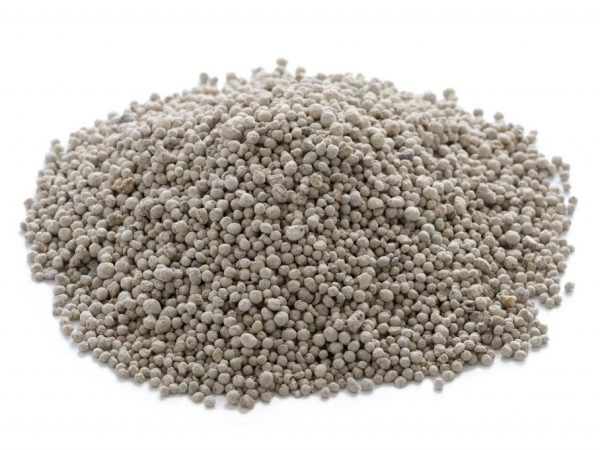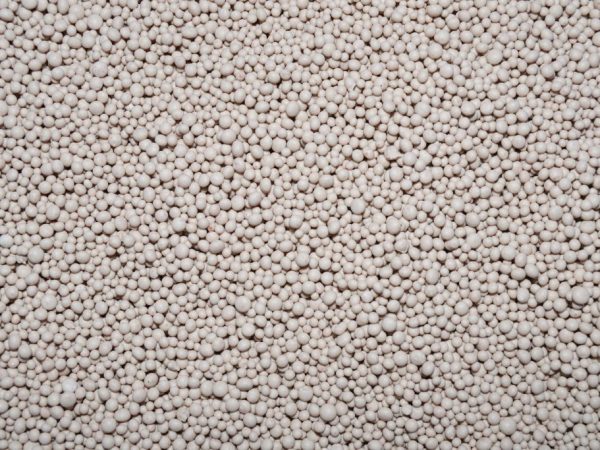Nitroammophoska for cucumbers
The increased exactingness of the culture to soil fertility is determined by its high early maturity and a rather poorly developed root system, therefore, nitroammophoska for cucumbers can become a source of all necessary substances and elements even in depleted soil conditions.

Nitroammophoska for cucumbers
Chemical composition
Nitroammofoska is one of the most popular chemical fertilizers with a high content of nutrients. The mineral product is used as the main and for sowing feeding for cucumbers of various varieties, allowing you to get a rich harvest with a minimum of maintenance.
The fertilizer contains nitrogen, phosphorus and potassium, which have a complex effect on seedlings:
- Nitrogen. Promotes the rapid growth of green mass required for optimal metabolic rate and photosynthesis. With its deficiency, the vegetative period of the individual is shortened, the growth and formation of fruits stops.
- Phosphorus. Forms new ovaries and strengthens the root system, most important for young seedlings.
- Potassium. It is especially necessary during the period of active growth, ensures movement and assimilation of nutrients, affects the taste of fruits. A deficiency of this element slows down photosynthesis and reduces immunity to various types of diseases and insect pests.
The effectiveness of feeding cucumbers with nitroammophos is also facilitated by the variety of forms of nutrients in its composition. For example, various phosphorus compounds contained in the product dissolve easily in water or nitric acid. This property allows you to quickly transform the elements for plant saturation, thereby increasing the speed of the product.
Types of nitroammophos
At the moment, several types of chemicals are being produced, targeted for use in conditions of various types of soil. The chemical composition in them is the same (a combination of nitrogen, phosphorus and potassium), the differences are only in the percentage of components.
The most common types are:
- 16% of all elements in the composition of the top dressing, the main substances are contained in equal proportions. This type of chemical contains useful elements in almost half of the total mass. It is used on all types of soils, i.e. has universal application.
- 8% nitrogen, 24% phosphorus, 24% potassium. It is used on soils with a pronounced deficiency of phosphorus and potassium.
- 17-21% nitrogen, 0.1% phosphorus, 21-28% potassium. Optimal with a lack of nitrogen and potassium in the soil and a high content of phosphorus.
Advantages and disadvantages
Like any other chemical fertilizer, nitroammofoska has its positive and negative qualities and requires careful adherence to the rules of application. Violation of instructions can lead not only to a decrease in the effectiveness of feeding, but also to harm to humans, soil and fertilized crops.
Positive properties

Fertilizer contains essential elements for plant growth
The advantages of using the product in the cultivation of cucumbers include:
- a high indicator of the concentration of nutrients in the composition (approximately 35-50% of the total mass, depending on the type);
- fast solubility of the chemical in water;
- the content of three elements most important for plant development (nitrogen, phosphorus and potassium) in one granule;
- good preservation and transportability during the entire warranty period;
- versatility of use (suitable for different types of soils);
- high level of application efficiency.
Nitroammofosk is ideal for use in soils affected by the bear. Unlike organic fertilizers, it does not lead to an increase in the growth of the insect population (with the same effectiveness of the effect of feeding).
Negative properties
The disadvantages of fertilization with nitroammophos are:
- chemical origin of the drug;
- short shelf life (six months from the date of production of the chemical);
- uncontrolled use can lead to the accumulation of nitrates in the soil and fruits;
- highly flammable and explosive, requires special care during storage and use.
For most gardeners, the effectiveness of exposure and increased crop yield outweighs the potential risks of using this chemical. But it is necessary to feed cucumbers with a chemical agent, like other crops, only after reading the instructions from the manufacturer and carefully following it.
Precautions for use
To prevent threats to human life and health, the following requirements must be adhered to:
- Under no circumstances should the temperature in the storage room be allowed to rise above 30 °. An ideal place for storing a chemical will be a room made of brick, concrete or other refractory materials.
- Control the level of humidity in the air in order to avoid loss of properties (maximum allowable value is 50%).
- Strict exclusion of the possibility of exposing the chemical to open flames and heating devices.
- To prevent the occurrence of unexpected chemical reactions, the nitroammophos should not be stored in direct access to other chemicals.
- The product can be transported only by land transport, observing the optimal humidity and air temperature.
- It is forbidden to store and use after the expiration date.
- When using the fertilizer, observe safety measures (use of gloves, respirator, etc.) and do not allow the chemical to come into contact with exposed skin.
- Storage of nitroammophoska is carried out exclusively in places inaccessible to children and pets.
Careful adherence to these rules will make the use of chemical feeding safe and effective.
Application
One of the most important advantages of the chemical is its versatility in various types of soil. But the most effective for increasing yields will be the use of the agent on well-moistened chernozem and gray earth soils.
It is recommended to feed cucumbers with nitroammophos in the open field or in a greenhouse several times during the growing season:
- Before planting the crop, the chemical is introduced into the soil at the rate of 30g per m2, the arable layer is thoroughly loosened up to evenly distribute the fertilizing.
- Before the appearance of the first ovaries, it is necessary to process each plant at the rate of 400-500 ml of the finished product per one bush. The drug is diluted in the following proportion: 40 g of fertilizer (2 tablespoons) per bucket of water (10 liters).
The composition of the chemical has a two-step effect on the crop:
- immediate effect - release of nitrogen, which contributes to the growth of green mass;
- delayed effect - occurs a few weeks after application, when water-soluble phosphorus compounds (ovary formation) and potassium begin to act (promotes the production of plant sugars in cells and the accumulation of pulp).
Conclusion
It is important to remember that it is necessary to feed the cucumbers with a chemical preparation in compliance with all safety requirements. Correct fertilization will help to increase the number of productive ovaries, improve the quality characteristics of fruits and the timing of fruiting crops.


